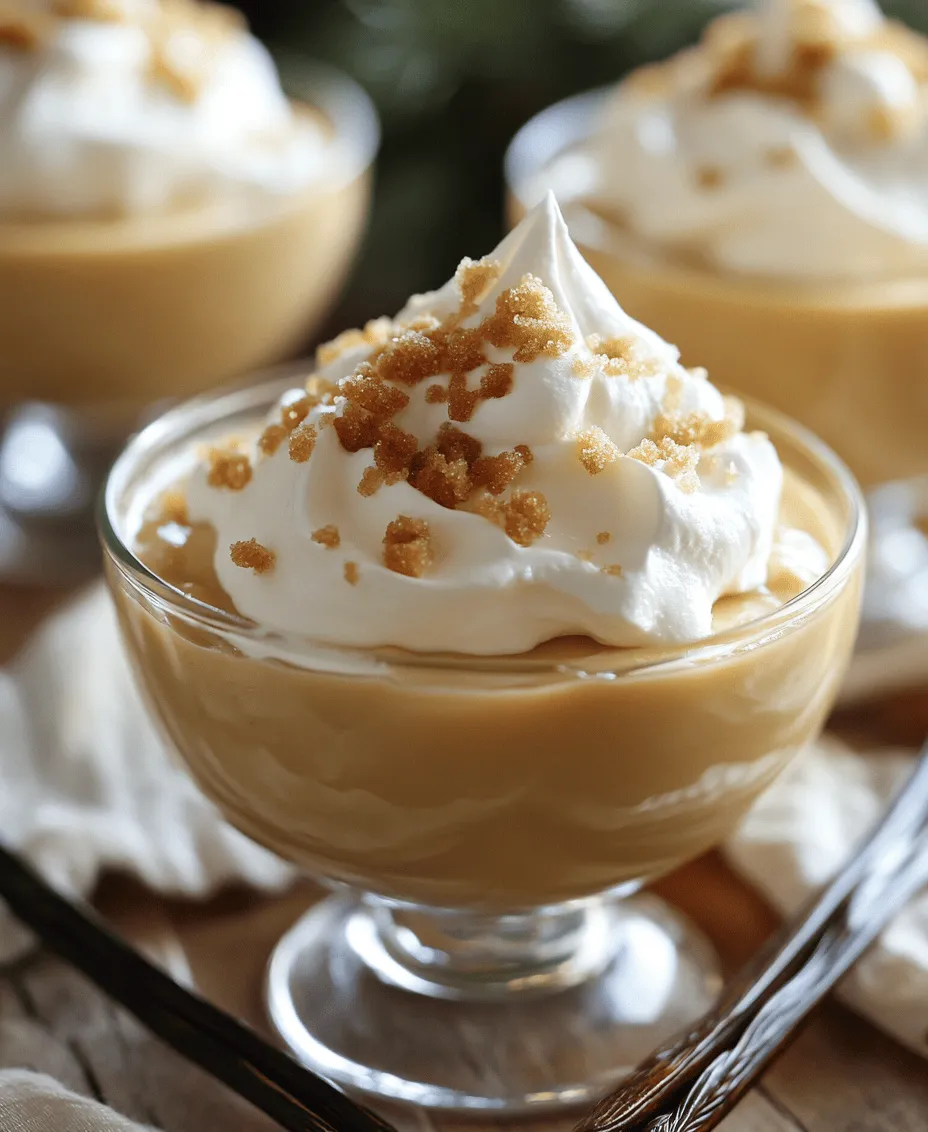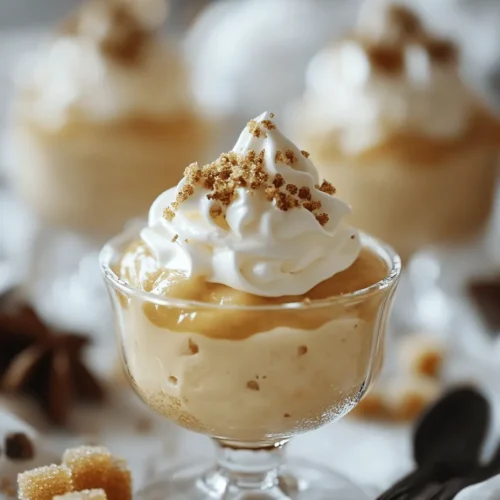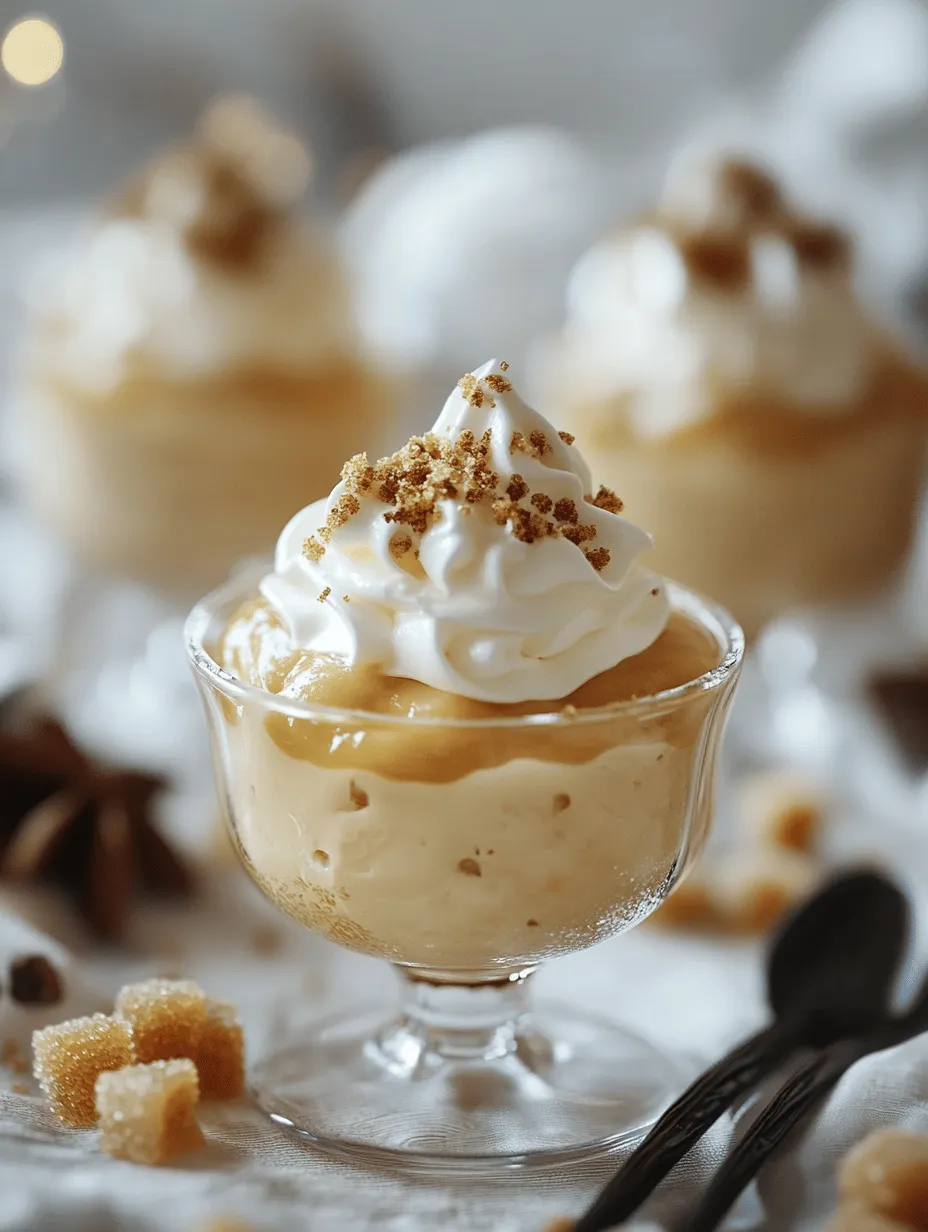Introduction
Butterscotch pudding is more than just a dessert; it is a warm embrace of nostalgia that transports many of us back to our childhood kitchens, where sweet aromas wafted through the air, and simple pleasures reigned supreme. Its creamy texture and rich, caramelized flavor make it a quintessential comfort food that can brighten any day, whether enjoyed alone or shared with loved ones. This delightful treat is perfect for any occasion, from cozy family dinners to elegant gatherings, proving that sometimes the simplest recipes can bring the greatest joy.
In this article, we will explore the making of Butterscotch Pudding Delight—a luscious dessert that is not only easy to prepare but also packed with flavor. From understanding the unique flavor profile of butterscotch to breaking down the essential ingredients and providing clear step-by-step instructions, we aim to equip you with all the knowledge needed to create this delightful pudding in your own kitchen.
Understanding Butterscotch: The Flavor Profile
To appreciate butterscotch pudding fully, it’s essential to understand what butterscotch is and where it comes from. Butterscotch is a confectionery treat, traditionally made from brown sugar and butter, which are heated together to create a rich, caramel-like flavor. This delightful combination is often enhanced with a splash of cream or milk, providing a smooth and velvety texture that is both satisfying and indulgent.
The origins of butterscotch can be traced back to the British Isles, where it was first documented in the 19th century. Over time, it has evolved into a beloved flavor in various desserts, particularly puddings and sauces. The unique flavor profile of butterscotch sets it apart from similar desserts like caramel or toffee. While caramel relies heavily on white sugar, butterscotch’s distinctive taste comes from the use of brown sugar, which imparts deeper, more complex flavors due to its molasses content.
In comparison to caramel pudding, which tends to be on the sweeter side, butterscotch pudding has a rich, buttery essence that balances the sweetness. The combination of these flavors creates a dessert that is both comforting and sophisticated, making it a favorite among dessert lovers of all ages.
Ingredients Breakdown for Butterscotch Pudding Delight
Now that we have a foundational understanding of butterscotch, let’s dive into the ingredients that make up our Butterscotch Pudding Delight. Each component plays a crucial role in achieving the perfect pudding consistency and flavor.
Brown Sugar
Brown sugar is the star of our butterscotch pudding. Its unique sweetness and caramel notes arise from the presence of molasses, which gives butterscotch its characteristic flavor profile. When heated, brown sugar melts and caramelizes, contributing to the pudding’s rich taste. For those looking for a less sweet alternative, light brown sugar is ideal, while dark brown sugar can be used for a more robust flavor.
Cornstarch
Cornstarch serves as the essential thickening agent in our pudding. When mixed with liquid and heated, it undergoes a process called gelatinization, which transforms the mixture into a silky-smooth pudding. Using the right amount of cornstarch is crucial; too little will result in a runny pudding, while too much can create a gummy texture.
Whole Milk
The choice of milk significantly impacts the creaminess and richness of our dessert. Whole milk is preferred for its higher fat content, which contributes to the luxurious mouthfeel of the pudding. However, for those with dietary restrictions, low-fat milk can be substituted, although it may result in a slightly less creamy texture.
Unsalted Butter
Butter enhances the flavor and texture of the pudding, providing a silky finish that perfectly complements the sweetness of the brown sugar. Using unsalted butter allows for better control over the overall saltiness of the dessert, ensuring that the butterscotch flavor shines through.
Vanilla Extract
Vanilla extract is a classic addition to many desserts, and butterscotch pudding is no exception. This aromatic ingredient adds depth and complexity to the flavor profile, elevating the overall experience. Opt for pure vanilla extract for the best flavor, as artificial versions can be overly sweet and synthetic.
Heavy Whipping Cream
For those who love a decadent touch, heavy whipping cream is a delightful topping for butterscotch pudding. Whipped to soft peaks, it adds an airy texture that contrasts beautifully with the dense pudding base. You can also use whipped cream as a decorative element, making the dessert visually appealing.
Ingredient Substitutions
If you have specific dietary preferences or restrictions, there are several substitutions you can make without compromising the integrity of the pudding. For a dairy-free version, consider using almond milk or coconut milk in place of whole milk, and coconut cream as a substitute for heavy whipping cream. For those looking to cut back on sugar, alternative sweeteners such as maple syrup or agave nectar can be used, keeping in mind that they may alter the flavor slightly.
Step-by-Step Instructions for Making Butterscotch Pudding
Now that we’ve covered the essential ingredients, it’s time to roll up our sleeves and get cooking! Follow these clear and concise directions to create your own Butterscotch Pudding Delight.
Step 1: Whisking and Combining Dry Ingredients
Begin by gathering all your dry ingredients: brown sugar, cornstarch, and a pinch of salt. In a medium saucepan, combine these ingredients thoroughly using a whisk. This step is crucial, as it ensures even distribution of the cornstarch, which will help thicken the pudding when heated. Whisk until there are no lumps, and everything is well incorporated.
Step 2: Adding the Milk
Once the dry ingredients are well mixed, gradually add the whole milk to the saucepan. It’s best to pour the milk in slowly while continuing to whisk. This method prevents any clumps from forming and helps create a smooth mixture. Once all the milk is added, continue to whisk until the mixture is uniform and free of lumps.
Step 3: Cooking the Mixture
Place the saucepan over medium heat and bring the mixture to a gentle simmer. It’s essential to stir continuously during this process to prevent sticking and to ensure that the pudding cooks evenly. As the mixture heats up, you will notice it gradually thickening. Keep stirring until you see bubbles forming at the surface, which indicates that the pudding is close to being done.
Step 4: Incorporating Butter and Vanilla
Once the pudding has reached the desired thickness, remove it from the heat. Add the unsalted butter and vanilla extract to the mixture, stirring until the butter has completely melted and is well incorporated. This step enhances the flavor and adds a luxurious finish to the pudding.
Step 5: Cooling the Pudding
After the butter and vanilla are fully blended, pour the pudding into serving dishes or a large bowl. Cover the surface with plastic wrap, ensuring it touches the pudding to prevent a skin from forming as it cools. Allow the pudding to cool at room temperature for about 30 minutes, then transfer it to the refrigerator to chill for at least two hours, or until set.
This comprehensive guide to creating Butterscotch Pudding Delight will have you savoring this creamy, comforting dessert in no time. Stay tuned as we continue with more tips and variations to elevate your pudding experience!

Gradual Incorporation of Milk to Avoid Lumps
To achieve the perfect consistency in your butterscotch pudding, it’s crucial to incorporate the milk gradually. Start by adding a small amount of milk to your dry ingredients—sugar, cornstarch, and salt—before whisking them together. This technique helps to create a paste that will prevent lumps from forming as you gradually add the rest of the milk.
Continue to pour the milk in a slow, steady stream while whisking continuously. This method not only ensures a smooth mixture but also allows for even distribution of heat during the cooking process. The key here is patience; take your time to whisk thoroughly and ensure that every bit of the dry ingredients is fully incorporated into the milk.
Cooking Process: What to Look for When Thickening
Once your mixture is well combined, transfer it to a medium saucepan over medium heat. As you heat the mixture, keep stirring regularly with a wooden spoon or a heat-resistant spatula. It’s essential to pay attention to the texture and consistency of the pudding as it cooks.
You will notice the pudding begin to thicken after a few minutes. Look for a velvety, custard-like texture; it should be thick enough to coat the back of the spoon. This thickening process typically takes 5 to 10 minutes. Be vigilant and avoid letting it boil, as this can lead to a grainy texture. If you see bubbles forming, reduce the heat slightly to maintain a gentle simmer.
Mixing in Butter and Vanilla: Achieving a Smooth Texture
Once your pudding has reached the desired thickness, it’s time to enhance its flavor and texture by mixing in the butter and vanilla extract. Remove the saucepan from the heat and add 2 tablespoons of unsalted butter. Stir until the butter has melted completely into the warm pudding. This step contributes to a rich, creamy mouthfeel that makes butterscotch pudding so delightful.
Next, add 1 teaspoon of pure vanilla extract. The vanilla not only complements the butterscotch flavor but also adds a depth that elevates the overall taste experience. Stir thoroughly to ensure that both the butter and vanilla are evenly distributed throughout the pudding.
Chilling the Pudding: Importance of Refrigeration to Develop Flavors
After incorporating the butter and vanilla, it’s important to let your butterscotch pudding cool before transferring it to the refrigerator. Allow it to sit at room temperature for about 15 minutes, which helps to prevent condensation from forming in the dish.
Once cooled, pour the pudding into individual serving dishes or a large bowl, then cover it with plastic wrap. Ensure that the plastic wrap is in direct contact with the surface of the pudding to prevent a skin from forming. Refrigerate for at least 2 hours, allowing the flavors to meld and the pudding to set properly. The chilling process is crucial for achieving that classic, smooth pudding texture that we all love.
Preparing the Whipped Cream Topping: Tips for Perfect Texture
While your pudding is chilling, it’s a great time to prepare the whipped cream topping. Using heavy cream is essential for creating a stable whipped cream that will hold its shape. Start by chilling your mixing bowl and beaters in the refrigerator for about 15 minutes before whipping.
In your chilled bowl, pour in 1 cup of heavy cream and add 2 tablespoons of powdered sugar and 1 teaspoon of vanilla extract. Begin whipping the cream on medium speed until it starts to thicken. Once soft peaks form, increase the speed to high and whip until stiff peaks hold their shape. Be careful not to overwhip, as this can lead to a grainy texture.
Once your whipped cream is ready, you can either dollop it on top of each serving of pudding or pipe it for a more decorative presentation.
Serving Suggestions and Presentation Ideas
When it comes to serving butterscotch pudding, you have a variety of options. Individual servings in small cups or mason jars create an elegant presentation and are perfect for gatherings. Alternatively, serving the pudding in a large bowl allows guests to help themselves, making it a great choice for family-style dining.
For garnishing, consider adding a sprinkle of chocolate shavings or finely chopped nuts to each serving for an extra layer of texture and flavor. Fresh fruit, such as sliced bananas or berries, can also complement the sweetness of the pudding beautifully.
If you want to elevate the dessert further, consider pairing your butterscotch pudding with other desserts like brownies or a slice of pie. The contrast between the creamy pudding and a denser dessert can create a delightful dining experience. Additionally, serving it alongside a cup of freshly brewed coffee or a rich cup of espresso can enhance the flavors and round out the meal perfectly.
Nutritional Information
Understanding the nutritional content of your butterscotch pudding can help you enjoy it mindfully. Each serving of butterscotch pudding (approximately 1/2 cup) contains around 250 calories, 10 grams of fat, 38 grams of carbohydrates, and 3 grams of protein.
While this dessert is certainly indulgent, moderation is key. Enjoying it as a special treat rather than a regular component of your diet allows you to savor its creamy goodness without overindulging. If you’re looking for health-conscious adaptations, consider substituting some of the sugar with a natural sweetener like maple syrup or using a lower-fat milk alternative.
Cultural Significance of Pudding Desserts
Pudding desserts hold a cherished place in many cultures around the world, each with its own unique spin on this comforting dish. In the United States, butterscotch pudding has become a beloved classic, often evoking nostalgia for childhood memories of family gatherings and holiday celebrations.
In British cuisine, puddings range from savory to sweet, with dishes like bread pudding and Yorkshire pudding being staples. The influence of British desserts is evident in many American recipes, including the beloved butterscotch pudding, which has become a highlight of dessert menus across the country.
Personal anecdotes about enjoying butterscotch pudding often highlight its comforting nature, reminding people of family dinners or special occasions. Whether served at a festive gathering or as an after-school treat, butterscotch pudding has a way of bringing people together, evoking a sense of warmth and nostalgia.
Conclusion
Making butterscotch pudding is not only a culinary endeavor but also an experience filled with joy and simplicity. The process of combining simple ingredients to create a creamy, sweet dessert connects us to cherished memories and traditions.
As you prepare your own batch of butterscotch pudding, reflect on the nostalgia it brings and the comfort it provides. This delightful recipe is not just about the sweetness; it’s about the moments shared with loved ones over a bowl of homemade goodness. We encourage you to give this classic dessert a try in your own kitchen. With each spoonful, you’ll be reminded of the warmth and happiness that comes from making—and enjoying—this beloved treat.


